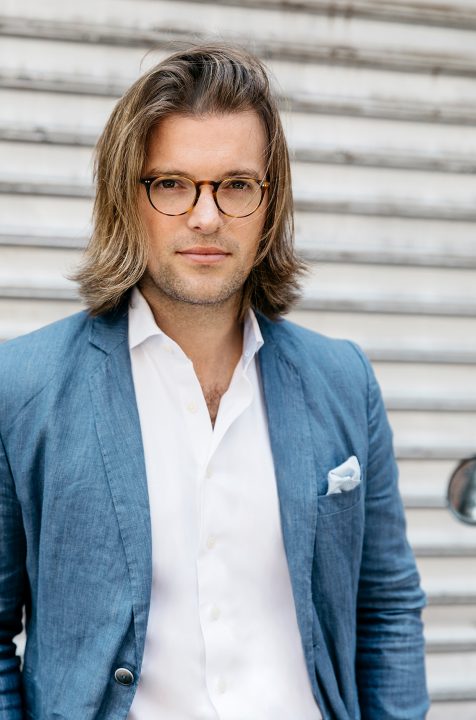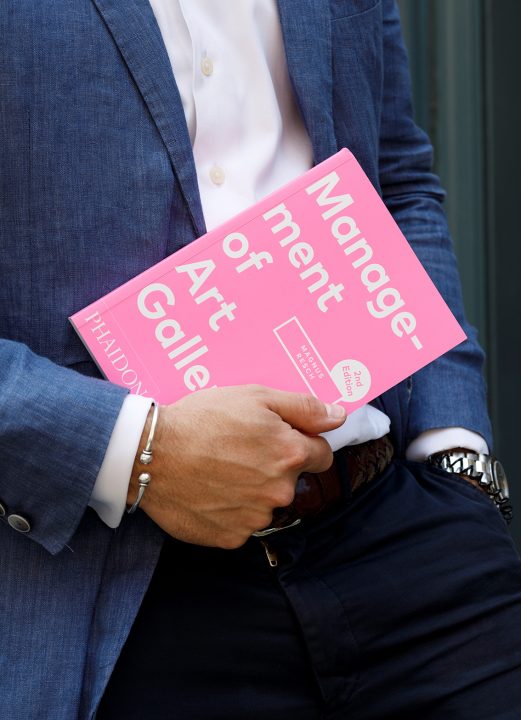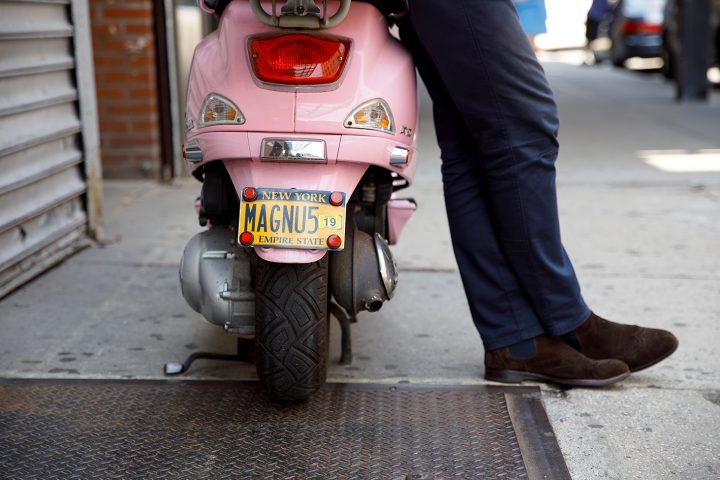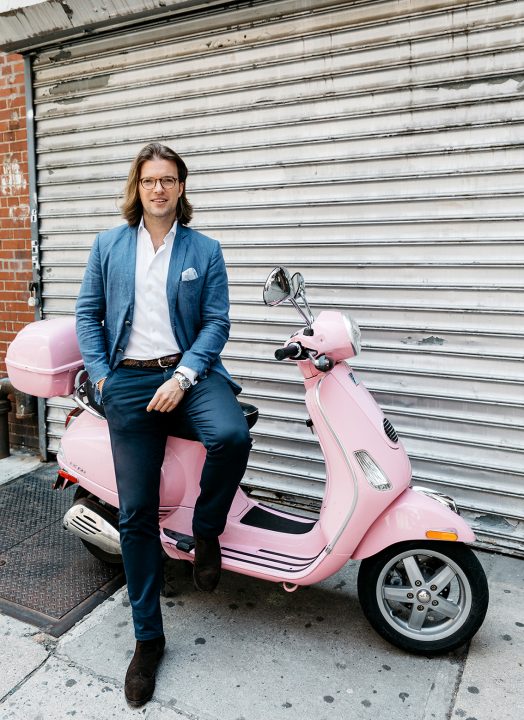By Marie-Ève Lafontaine | Photography: Helga Traxler
Artsy has named him “The art world’s most controversial economist”. Germany’s most reputable newspaper, the Frankfurter Allgemeine Zeitung, has called him “The Great Gatsby of the Art World”. The art blog Hyperallergic simply hates him.
Magnus Resch, 33, polarises. Educated in Harvard, the London School of Economics and with a Ph.D. from Hong Kong University and the University of St. Gallen, the native German moved to New York City from Berlin in 2014. His namesake app, Magnus, delivers gallery visitors the price of an artwork with one snap.
We sat down with Magnus to discuss the app, his activities in the art world and his pessimistic view on the art market. In our discussion we met a cynical, at times provocative, entrepreneur and academic whose unconventional views have gained a prominent following as the co-author of several books, including the controversial bestseller Management of Art Galleries.
Marie-Ève Lafontaine: Seeing that you were born in a small town in Bavaria and your own education was primarily in economics, how did you get into the business of art?
Magnus Resch: I went to high school close to the famous art academy in Dusseldorf, where Beuys, Richter, Gursky and others taught. Due to the proximity of the art academy, I met a few young artists. Eventually, I started selling their works. I continued doing this throughout my studies until I decided to focus on other activities.
MEL: In your book Management of Art Galleries you write that the art world exists at an intersection of aesthetics and finance. Joseph Beuys summed up these concepts in a simple formulation: “Kunst = Kapital” (art = capital). It is difficult to deny that the system today increasingly fails to reflect the personal struggles which artists face in balancing artistic development and intellectual depth with commercial considerations. What is your opinion on this?
MR: The art market, as we know it today owes its primary characteristics to the roots of the modern economy. In the Western art historical narrative, the myth of the lone artistic genius – the concept of an artist as we understand it to be today – is a relatively recent development. In fact, it dates from the Romantic era. Until then artists were not really considered anything than skilled workers producing luxury goods for the upper classes and the Catholic church. Take, for example, the well-known example of the Medici’s, who effectively financed culture in both of these spheres. Until the Renaissance, there are not many instances in which we can even know the names of artists as they rarely signed their works. Today it would be a bit comparable to going to an upscale tailor and asking for a new suit. Does a tailor sign his suit? As tradesmen, artists were hired to make portraits and devotional pictures for affluent patrons – as such they were a vital supplier to the luxury economy and directly contributed to the rise of city-states such as Florence. Supply followed demand: back then the market was small but efficient. So you see, art has always been a sort of capital, whether real or symbolic. The great thing about religious art is that it is automatically both.
Today’s situation is different. In the 20th century (especially in the post-WWII decades) it became somehow chic to become artist. We see a huge increase in the number of students choosing to pursue a career in what appeared to be a promising venture. This mass-commodification of creativity has led to the exceptional crisis we are faced with today: we actually have an oversupply of artists fighting over a relatively little demand for high art. There are too many galleries, too many artists and not enough collectors.
MEL: Early this year American artist Robert Cenedella, a professor at the Art Students League in New York, filed a federal class-action lawsuit against five major American arts institutions over their alleged manipulation of the contemporary art market. He claimed that the institutions were part of a “corporate museum cartel,” who were trying to increase prices for certain contemporary artworks within domestic and international art markets while suppressing prices of others. Would you agree that this might be a conscious decision of large institutions or rather a general move provoked by other economic pressures?
MR: Right now, two different art worlds exist side by side in the international art market: the first, which we will call the ‘Super-League’ contains roughly 25 galleries, 25 artists, 25 museums and 100 collectors. Either you are in it or you part of the rest, the losers. It’s fairly easy to identify the participants of the Super-League because they are all connected through their artists. The 25 artists are those that sell well at auctions. They exhibit at those galleries which you find at Art Basel each year on the ground floor around the atrium. The Super-League museums are those where these artists are being shown, and the Super-League collectors are the ones who sit on their boards. Let me highlight these points with three sets of data:
a) 60% of all relevant collectors are involved in the boards of public museums.
b) 25 artists make up 50% of the total revenue at contemporary art auctions in 2017
c) One-third of all solo museum exhibitions across the United States between 2007 – 2013 were of artists from five galleries.
“In the 20th century (especially in the post-WWII decades) it became somehow chic to become artist. We see a huge increase in the number of students choosing to pursue a career in what appeared to be a promising venture. This mass-commodification of creativity has led to the exceptional crisis we are faced with today: we actually have an oversupply of artists fighting over a relatively little demand for high art.”


MEL: Would you say that this practice is beneficial or harmful to the art market as a whole? It would seem that such a self-reinforcing system creates a dangerous bubble.
MR: Inherently speaking, there is nothing bad about this. Art market participants just need to be honest about these figures and let new buyers know that the re-sell value of art is close to nothing – unless they buy one of the Super-League’s artist. Art is a terrible investment. When you look at the price development over the past 40 years, less than 2% of artists in the secondary market significantly outperform the stock market. My best friend is an investment banker in London. He often asks me what artists he should collect. What he is really asking is “how can I make money with art?”. I always tell him: buy Picasso, buy Monet. But that’s a boring answer, so he leaves me alone for 3 months until he comes back to me because he met a great gallerist at Loulou’s who told him about this great emerging artists with great representation and great upcoming solo shows in great museums in Wisconsin and Dover. Then the whole process starts over.
MEL: In your book “100 Secrets of the Art World”, which you authored together with BMW’s cultural head Thomas Girst, many contributors paint a rather grim picture of the market. Why is this?
MR: The art market is not as attractive as the media tries to convince us it is. I already mentioned the Super-League – this is where the glamour is happening, where artists score these sensational record prices. The rest is everyone else – this part is in very poor shape. 30% of all galleries operate at a loss, 99% of all artists cannot live alone from their practice, and the total revenue of the market is only $50bn. To put things in perspective, that’s what a single company like Fedex is making on a yearly basis. Even then, we should keep in mind that there are even several similar companies of the same size offering nearly identical services: DHL, UPS, etc. This indicates a huge market. In comparison, the art world is an incredibly small market where really only the members of the Super-League are making money. Everybody else around them is actually poor, but at least they look chic. This is what the contributors in 100 Secrets point out repeatedly.

MEL: So what’s the solution to this problem?
MR: The Dutch economist Olav Velthuis presents a hint in the book. He says: “The art market has doubled since 1990, however, in the same time period the number of billionaires has increased fivefold.” To come back to my previous terminology: while the supply side is growing, the demand side is going down. 20% less artworks were sold in 2017 compared to 2007. In other words: The art market is actually collapsing.
My original goal in creating my app was to change this situation. I believe that transparency in the art market is the solution. Price transparency converts visitors into buyers. Several scientific studies show that the lack of transparency is the reason that people are not buying art. By simply taking a photo, a potential buyer can see the price of the work, plus comparable prices. An increase in a number of buyers means that a greater number of galleries and artists can actually live from creating art. Magnus helps to make the market transparent.
MEL: And this should work?
MR: When Hans Neuendorf launched Artnet in the 90s, the auction houses were furious. Their fear was that transparency would decrease the number of buyers. However, they soon realized that Artnet was actually attracting a new group of buyers because the price data gave potential clients confidence in their decisions. In this sense, Hans Neuendorf is probably the biggest game-changer in the history of the art market. My app enhances this idea: we not only cover auction prices like Artnet but also prices from galleries – we cover the entire market. As Artnet did in the 90s, we are using the newest technology to bring the idea of transparency to the 21st century.
MEL: Art enthusiasts and buyers are increasingly viewing exhibitions online instead of attending brick and mortar spaces. What would you say has been the effect of the rise of Web 2.0 on the perception of a work’s value? I am speaking in particular of primarily visual platforms like Instagram.
MR: Instagram is another way to see art, not to buy art. Access to art is not a problem today. There has never been a time when it was so easy to experience art. Many notable museums are completely free. There are 300 art fairs currently taking place around the globe, 20,000 galleries worldwide, pop up shows everywhere, and in some cities you can even see museum art during the night – if you haven’t made it on one of the 200 other open days in the year. The real problem is the conversion to the market. How can we convert these viewers into buyers?
“Instagram is another way to see art, not to buy art. Access to art is not a problem today. There has never been a time when it was so easy to experience art. Many notable museums are completely free. There are 300 art fairs currently taking place around the globe, 20,000 galleries worldwide, pop up shows everywhere, and in some cities you can even see museum art during the night”

ML: What is your opinion of platforms like Collecteurs, which aim to support the cultural value of art, even when it is hidden from view? Is this a threat to the status quo of art market dynamics or does it represent a more egalitarian approach to the benefits of cultural investment?
MR: Tech & art is a marathon, not a sprint. Almost all companies in this field have failed because they ran out of money. I am grateful, for example, that Artsy and their fantastic team has the funds to stay in the game longer. The art world simply doesn’t embrace change. The launch of my app was also met with a lot of resistance. Instead of welcoming the idea of opening up the market, many galleries try to keep the market opaque. They fear a transparent market simply because the market has always been opaque. It is equally frustrating to see that even young galleries copy the Gagosian model, i.e. a central location, extensive art fair participation, international footprint, and appearance of exclusivity. I wish this platform success and that their investors have a long breath.
MEL: In general, what is your attitude to collecting? Is it ‘to enable and protect history’ or a purely selfish action? From what I understand you are also a collector yourself.
MR: The word collector is totally overused. We should talk about buyers instead. You don’t call someone who buys his second watch a collector, right? I am a buyer. I buy art if I see something that I like. If I don’t like it anymore, I sell it. But this never works. The moment I leave the gallery, my $10,000 are lost. But at least I get pleasure from looking at it, my friends admire me as a cultivated art aficionado, the artist (if she ever sees the money) can pay the rent and the gallerist will always invite me to the VIP opening her next art fair. When you see it through this lens, maybe it is not such a bad deal either.

 Español
Español